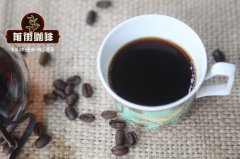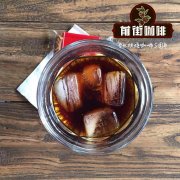Yerga sherry coffee taste characteristics. What is Shelby Coffee Cooperative?

Professional coffee knowledge exchange more coffee bean information please follow the coffee workshop (Wechat official account cafe_style)
Ethiopia is the country where coffee was first discovered. Today, there is still a lot of wild coffee picked and used by farmers in the virgin forest. Ethiopia is a country with poverty, drought and civil war. However, it is still the most important coffee producer in terms of coffee quality and output.
Ethiopian coffee can be divided into two treatments. Natural washing treatment II. Natural sun treatment. Nowadays, every producing area, cooperative and even small coffee farm in Ethiopia produces coffee beans of the above two treatments at the same time, such as the well-known Yegashifi or Sidamo province.
The coffee beans washed with water have low fragrance and low temperature, low citric acid softness, high flavor consistency and taste, while the coffee beans washed by sun have strong and conspicuous aroma, weak citric acid and complex flavor.
Ethiopia is currently the country with the fastest production and development of coffee. Different producing areas not only make coffee different in terms of treatment, but also make aroma and taste different due to different processing methods, which often give people the wrong impression. For example, the aroma of Yejiaxuefei sun-dried beans is different from that of Sidamo sun-dried beans. Yega Xuefei's sun-dried beans have a higher moisture content, coffee beans account for the majority of small grains, the aroma is low and stable, and the taste is thicker. The strong fragrance of the sun-dried beans in Sidamo is impressive, but the taste is thin.
In recent years, many emerging small producing areas or cooperatives in Ethiopia have sold in the market under the names of their own cooperatives, which shows confidence in their own coffee and hopes to establish brand reputation and loyalty in the coffee market. Coffee farmers insist on picking mature coffee beans and strictly handle every process. Both natural washing and natural sun drying show unexpected fragrance and excellent taste, which I think is why Ethiopian coffee is expected by coffee fans every year.
There is little difference in the appearance and size of coffee beans in the Shirba Coffee Cooperative, which can achieve a more perfect and consistent flavor of washed beans.
The Elba Coffee Cooperative (Chelba Coffee Farmers Cooperative Union), which is co-located with the former Yegashafi Coffee Cooperative in the Yegashafi producing area of southern Ethiopia, is made up of 490 coffee farmers and is a partner of the Rainforest Alliance in Ethiopia to help local communities and set up schools to help poor families by working directly with the Rainforest Alliance to get better prices. Consumers can also help poor coffee farmers by buying this type of coffee.
The Elba Coffee Cooperative is a Rainforest Alliance certified coffee bean with dark green and slightly defective beans in the shape of long rice similar to those of the previous Yega Sheffield Cooperative.
The coffee beans of the Elba Coffee Cooperative grow in a 5700-foot primeval forest, and high-altitude coffee beans are not easy to grow and mature. September and February are coffee harvest times and are native Arabica beans. 2009 the new season of Elba Coffee Cooperative is certified by the Rain Forest Alliance (R.A). The grade of coffee beans treated by natural washing is G2. The long rice shape of the beans is different from that of the previous batch of King's Coffee, which is the same as Yega Xuefei of YCFCU Coffee Cooperative. It is different from the fruit fermented aroma produced by multiple treatments of Ethiopian coffee in the sun, with fine citrus acid and obvious jasmine aroma. A good scent of jasmine is the most important way to distinguish Yega Xuefei.
The Elba Coffee Cooperative is a Rainforest Alliance certified coffee bean with a Rainforest Alliance logo (green frog) on the bag.
Important Notice :
前街咖啡 FrontStreet Coffee has moved to new addredd:
FrontStreet Coffee Address: 315,Donghua East Road,GuangZhou
Tel:020 38364473
- Prev

What is black ivory coffee? Have you ever heard of black ivory coffee?
Professional coffee knowledge exchange more coffee bean information please follow the coffee workshop (Wechat official account cafe_style) "Black Ivory coffee" produced in Thailand, the price per kilogram is as high as NT $33,000, a cup of black ivory coffee can cost up to US $50 (about NT $1500), pulling down about US $400 per kilogram (about NT $12,000), ranking the most expensive
- Next

Mexico has coffee beans besides tequila? Taste characteristics of Mexican coffee.
Professional coffee knowledge exchange more information about coffee beans Please pay attention to the coffee workshop (Wechat official account cafe_style) Coffee produced in Mexico has a long history and is now one of the important coffee producing countries in the world. The coffee produced in Mexico is naturally called Mexican coffee. About 5 ℃ of the total area of Mexico are plateaus and mountains, with an annual average temperature of 2527 ppm.
Related
- Beginners will see the "Coffee pull flower" guide!
- What is the difference between ice blog purified milk and ordinary milk coffee?
- Why is the Philippines the largest producer of crops in Liberia?
- For coffee extraction, should the fine powder be retained?
- How does extracted espresso fill pressed powder? How much strength does it take to press the powder?
- How to make jasmine cold extract coffee? Is the jasmine + latte good?
- Will this little toy really make the coffee taste better? How does Lily Drip affect coffee extraction?
- Will the action of slapping the filter cup also affect coffee extraction?
- What's the difference between powder-to-water ratio and powder-to-liquid ratio?
- What is the Ethiopian local species? What does it have to do with Heirloom native species?

